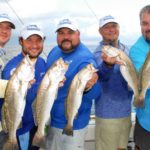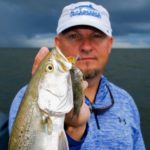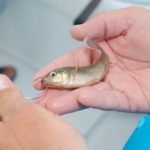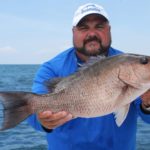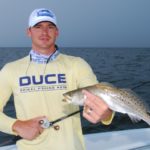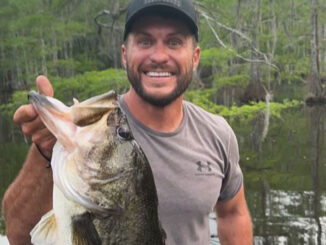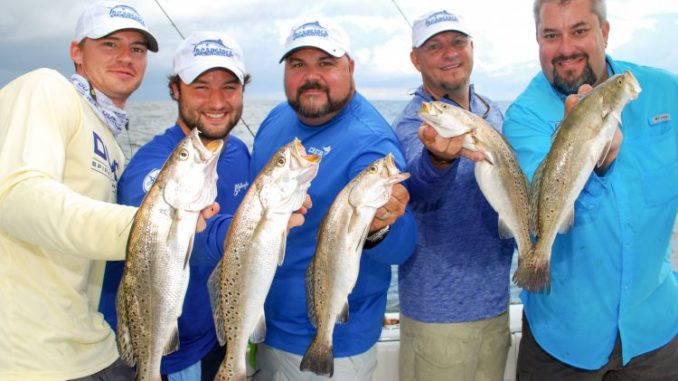
Even if the Atchafalaya River has finally allowed Vermilion Bay to clear up, this group of anglers head to the nearshore Gulf. That’s because they know plenty of solid trout and mangrove snapper await.
Fishing for speckled trout over here isn’t for sissies.
The five anglers left Shane Zeringue’s camp at Cypremort Point at 5 a.m., and it was going to be at least a 45-minute run in his 32-foot Offshore Yellowfin.
It ain’t a slow boat.
“It tops out at 56 mph but will cruise at 40 all day,” Zeringue told me the night before.
Good thing it was fast: Casey McLaurin had promised me a doubleheader — first speckled trout, and then mangrove snappers.
I was content, though. I still had a full tummy from the feast McLaurin and Lane Lemaire served up at the camp the previous evening. See this month’s Louisiana Seafood Bible column elsewhere in this issue for more on that.
As the boat rammed its way across Vermilion Bay and out Southwest Pass in the darkness, I thought about these guys. They were about as close to being pros as you can get, and still hold day jobs and have a families.
Between Memorial Day and Labor Day, they fish every free moment. From September through January, they hunt.
The rest of the time, they get antsy.
Zeringue, a Breaux Bridge resident, is an orthopedic implant sales distributor. McLaurin is the director of operations for Acadiana Outfitters, a large hunting and fishing retail outlet on the outskirts of New Iberia. LeMaire is a project coordinator for KourCo Environmental Services based in Lafayette.
These three men, along with two others not fishing with us, make up Team Bone-A-Fide, a group formed specifically for competitive tournament fishing — although most of what they do nowadays they call “recreational fishing.”
The other two men on the boat were Luke Hutson and Cade Eskridge.
At 21, Hutson was the youngest and is a student at the University of Arkansas. He was working for Zeringue for the summer. The endlessly cheerful and polite young man would spend more of the day taking care of the other fisherman than fishing himself.
Eskridge was part of the reason for the trip: He owns Duce Fishing Rods of Lafayette, a maker of high-end inshore saltwater and bass rods for serious fishermen.
McLaurin, always with an eye on new technology for fishermen, wanted to give Eskridge’s spiral-wrapped rods a workout.
Eighteen miles out of Southwest Pass, Zeringue throttled the horses back at the site of a recently removed platform in South Marsh Island Block 233. The location was marked with a red buoy emblazoned with the number 2 on it.
“For some reason, they never removed the buoy,” Zeringue said. “Then a shrimp boat sunk next to it. That structure really holds the fish.”
After the anchor bit and while the men began fishing live cocahoe minnows out of the livewell, they provided a primer on best conditions for offshore speck fishing.
“Clear water is one of the most-important things,” McLaurin said. “I look in the livewell: If I can see to the bottom of the well, the water is good.”
But other factors also play into the formula.
“Wind direction and water current are important too,” McLaurin noted. “Persistent east winds will push muddy river water into the areas we like to fish.”
Zeringue piped in that moving water is another key.
“I’m not a big tide guy,” he said. “But we have noticed that when the water isn’t moving, the bite is slow.
“When that happens, typically, we just wait it out.”
Enough trout were there to provide sporadic hook-ups.
So they decided to try a rig set in Vermilion Block 52, 1½ miles west of the buoy. The bite was intermittent there, as well.
They moved the boat repeatedly between the rig and the buoy, and they moved from side to side on the rig looking for a stronger bite.
“Sometimes the fish are on one side of the rig more than the other, so moving is absolutely important,” Zeringue said. “Of course, you have more of a tendency to move if you have an electric anchor windlass. We are in 18 feet of water. If you have to pick the anchor up by hand you have a tendency to sit in one spot and not move, even if you’re not catching fish.”
In spite of the irregular bite, they soon boated half of a boat limit. Hutson spent most of his time hustling for the older guys, netting fish, icing fish and washing the boat.
Then the mother of all rain squalls — one that had been menacing for some time — hit the boat.
Under eggplant-colored skies and slashing wind and rain, they rode it out, bow into the wind for 45 minutes.
After the weather passed, the trout were gone — from both places. The guys huddled and decided to make a run for mangroves instead of moving for speckled trout.
The 28-mile run farther offshore to the Vermilion Block 119 rigs put them in 68 feet of water. The water was gin-clear, not blue but green.
They tied the boat directly to the rig rather than anchor in the deep water. The men exchanged their casting reels for spinning reels rigged with leaders made of 65-pound-test fluorocarbon, which was tied to the line without the heavy egg sinkers used in trout fishing to allow the bait to drift naturally.
Here again, Hutson was the hero, doing the grunt work, standing in boat’s bow, breaking up Spanish sardines from a 5-gallon bucket and tossing occasional handfuls under the edge of the big platform to drift back toward the boat.
With the first handful of chum, 30 nice mangrove snappers dashed out from the rig’s protective legs to wolf down pieces of it.
LeMaire expertly flipped his cocahoe to them and hooked up. He was quickly followed by Eskridge and McLaurin.
They took four mangroves from that platform and moved. “We take the dumb ones, and then we move,” LeMaire said with a grin.
The next Block 119 platform gave up four more. The next yielded two. Another produced three, and so on, until their box was full of fish.
Big mangroves take up a lot of space.
“Let’s go to the camp and cook,” McLaurin yelled.
LeMaire just smiled.
